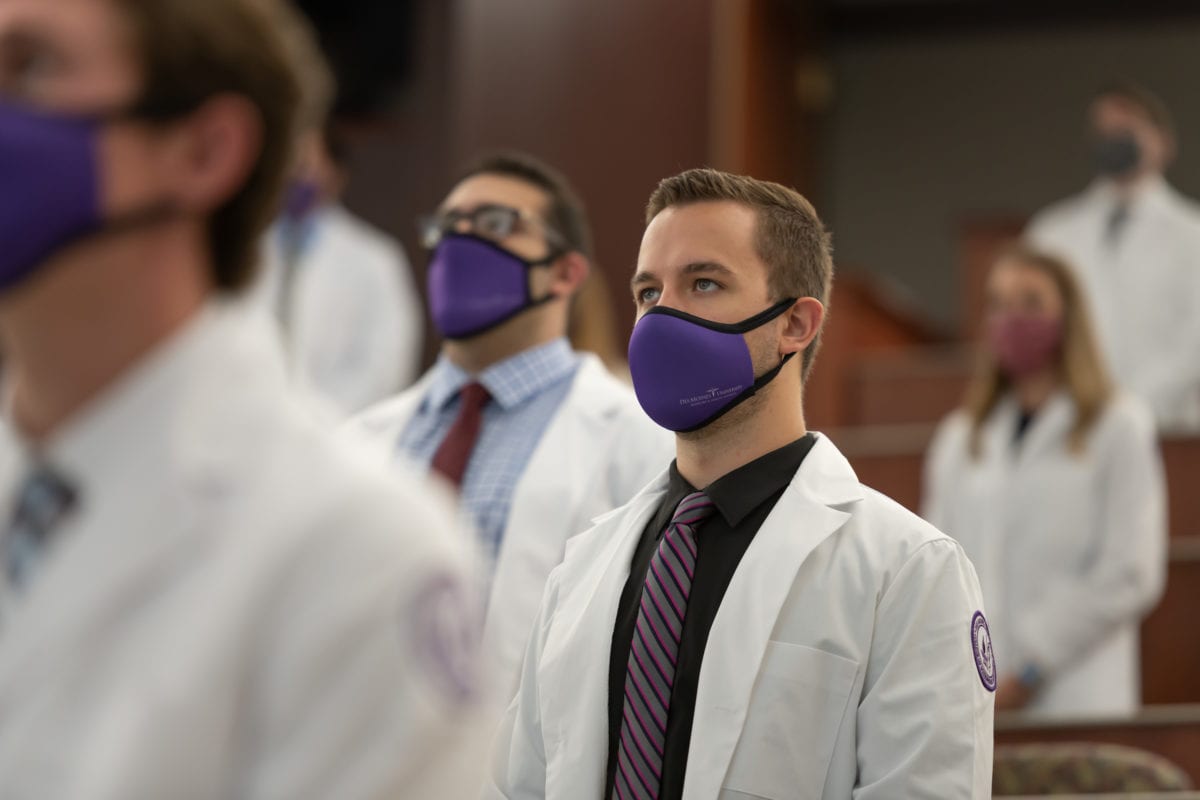
During six ceremonies on Aug. 20 and 21, students in DMU’s osteopathic medicine, podiatric medicine and surgery, physical therapy and physician assistant studies programs donned health care’s equivalent of superhero capes: their white coats. While the event looked different from past years due to the COVID-19 pandemic – attendees wore face coverings, and no guests were allowed – its significance was in no way diminished.
A compilation video of the six ceremonies is available here.
“Students, when you don the white coat today, you assume not only the responsibilities but also the obligations that attend to those who choose it,” said DMU President and CEO Angela Walker Franklin, Ph.D. “These obligations include to be honorable in all phases of your life. To excel in your academic studies and training. To be compassionate, to be accountable, to collaborate with others as an interprofessional team member and to support a culture of inclusiveness.
“By accepting these obligations, you become part of the legacy of thousands of Des Moines University alumni whose contributions to medical care have alleviated suffering, saved the lives of countless individuals and maintained the integrity and high ethical standards of the health care professions represented at the University,” she continued.
Donors provided all the white coats as an investment in students, who recited an oath to recognize their central focus on caring for the patient. Traci Bush, D.P.T., OTR/L, D.H.S., chair of the physical therapy program and associate professor, told students they were chosen to receive white coats because the faculty believe in their ability to earn the honor and because “we believe you are the people we want to carry our torch as physical therapists in our profession going forward.”
“This white coat symbolizes that you have the knowledge and skills to make incredible differences and profound impacts on your patients’ lives,” she said. “This white coat is a symbol to all health care providers that you are the movement specialists.”
Robert Yoho, D.P.M., M.S., FACFAS, dean of the College of Podiatric Medicine and Surgery, said the purpose of the white coat ceremony “aligns well” with DMU’s mission to educate highly competent and compassionate health care professionals.
“Your scientific knowledge and clinical skills will be assessed as you navigate your way through volumes of exams, SPALs, simulations and clinical objectives,” he said, referring to components of the podiatric curriculum. “Compassion, on the other hand, is a bit more challenging to teach and assess…Compassion is a characteristic integral to a person’s life, measured by actions deemed to be caring by others…Respect your white coat. Build your capacity for compassion. Share your story.”
Steven Halm, D.O., FAAP, FACP, dean of the College of Osteopathic Medicine, told students the white coat originated in scientific laboratories as a symbol of knowledge and then became the “standard of dress for physicians as they wanted to incorporate scientific principles into their practice of medicine.”
Dean Halm also said the white coat ceremony was created by the Arnold P. Gold Foundation in 1993 to welcome students to health care practice and elevate the value of humanism as the core of health care. Dr. Arnold Gold, a pediatric neurologist who taught at Columbia University Medical Center for more than 50 years, championed humanism and patient-centered care in medicine.
“On rounds Dr. Gold wanted to know about the lives of patients, not just their vital signs or their daily weights or their urinary output and oral intake,” Dean Halm said. “Model your professional life after Dr. Gold, and you’ll all be superstars…From this day forward, I want you to remember the legacy of Arnold P. Gold.”
Holland Taylor, M.S.P.A.S., PA-C, chair of the physician assistant studies program, reflected on being in her students’ shoes when she matriculated into the program in 2005 and her journey through the program’s 25 months and approximately 91 exams. She quoted Paracelsus, a 16th century physician, who said, “Medicine is not only a science; it is also an art.”
“The white coat very much symbolizes both of these,” Ms. Taylor said. “It is the symbol of evidence-based medicine closely aligned with research and science. It is a symbol of purity and cleanliness. It is a symbol of prestige and purpose. But more intimately, it is the symbol of our core values of our program at DMU – teamwork, integrity, professionalism and empathy.”

